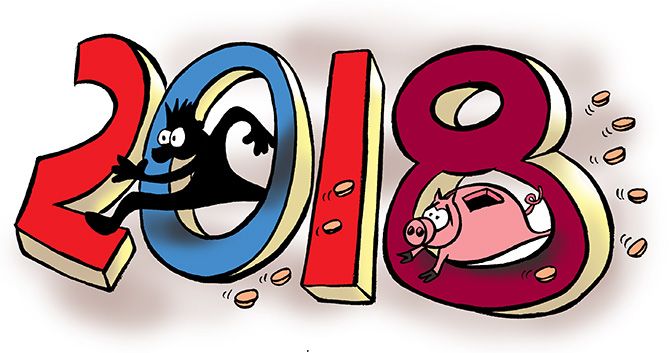'Monetary tightening by the global central banks, crude oil prices, geopolitical tensions (if any) and upcoming state elections are some factors that can lead to volatility in the markets.'
Illustration: Uttam Ghosh/Rediff.com

Corporate earnings and outcome of the Karnataka poll are two big events at the domestic level that are likely to keep markets choppy in May.
Swati Kulkarni, bottom, left, executive vice-president and fund manager - equities at UTI Mutual Fund tells Puneet Wadhwa that though mid-and small-cap companies are trading at a higher valuation as compared to large-cap peers, one can still find value in select pockets. Edited excerpts:
What has been your investment strategy thus far in 2018?
We have not changed our strategy in six months.
In UTI Mastershare, we follow a 'growth at reasonable price' approach.
At times market might underestimate long term-growth potential and value stocks accordingly. Our focus is to look for such opportunities.
One such recent example could be our investment in information technology (IT).
Six to eight months ago, we went overweight on the segment.
 The sector was available at an attractive valuation of 15 to 17 times price to earnings (PE) multiple; the benchmark index was around 26x.
The sector was available at an attractive valuation of 15 to 17 times price to earnings (PE) multiple; the benchmark index was around 26x.
The other major change in the past few months has been in the financial services, where we had an overweight exposure to retail banks and non-banking finance companies (NBFCs) for past two to three years.
We started increasing our exposure to private corporate banks where valuations looked attractive, assuming the normalisation of earnings over the medium term.
Do you still see pockets of value and growth in the large-cap segment?
The consumer discretionary sector has seen steady growth and is likely to continue.
I am positive on automobiles and consumer durables. Affordability has gone up and cash flows have started to improve, especially in rural areas.
Beside having aspirations, consumers are not much leveraged. This augurs well for the consumption story.
Commodity prices have been strong, especially crude oil. The energy sector does hold value in this backdrop.
Though the metal sector can be a bit volatile, the valuations are reasonable.
How comfortable are you with the overall market valuation?
The valuations were stretched in January. Despite the correction, these are still not in a comfort zone.
High valuations were partly on account of expected growth in corporate earnings, which the indices were supposed to deliver.
The S&P BSE Sensex is trading at 23 times trailing PE, though mid-caps are still at higher multiples.
Given the past history of earnings growth delivery, one needs to be cautious while investing.
The pace of downgrades seen earlier has gone down.
The consensus 25 - 27 per cent growth estimate for FY19 earnings could get corrected, as a number of variables could trigger this.
How do you see the markets over the next 12 months?
The best of the macro-economic environment, inflation, current account deficit (CAD) and fiscal deficit, is behind us.
On the other hand, the micros (fuel consumption, car volumes and discretionary demand) are improving.
Given the inflation pressure, there are chances that the rupee becomes volatile and interest rates stay firm.
Monetary tightening by the global central banks, crude oil prices, geopolitical tensions (if any) and upcoming state elections are some factors that can lead to volatility in the markets.
However, if the earnings deliver, we can sustain the current valuations.
Could the volatility trigger a slowdown in domestic fund flows into equities?
Domestic flows have been strong in the past two to three years.
Market returns in the past have attracted a lot of retail (individual) investors.
However, the fact that the correction or volatility might not have been understood by those who have started investing recently, the quantum of flow into the equity segment could be volatile.
With more investors understanding their asset allocation needs for achieving long-term financial goals, flows will become steadier.
Your views on the mid-and small-cap segments?
Though mid- and small-cap firms have higher valuation as compared to large-cap peers, one can find value in select pockets, such as construction, chemical and fertiliser, retailing, and utilities.
One needs to have a stock-specific approach.












 © 2025
© 2025